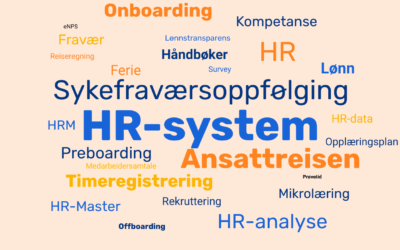What an HR system must contain

Guide: What you should look for in an HR system
4. Digital manuals
Having digital handbooks available, such as the HR and HSE handbook, will ensure that every employee can access important information about routines, objectives and legislation without always having to consult their employer or the company's HR department. Examples of such information could be: Mapping of the working environment in addition to questions such as: I want to report an unfortunate incident. Can I remain anonymous? or What is the biggest HSE risk at my workplace? It is important that the digital manuals are easily accessible to all employees, preferably in the employee portal.
Digital handbooks ensure that every employee can access important information about routines, objectives and legislation without always consulting their employer or the company's HR department
There are HR systems that have digital handbooks that are automatically updated in the event of changes to legislation, so you don't need to worry about changes to legislation regarding, for example, holiday entitlement. The information is updated automatically and if you get questions from employees about a topic in the Employee Handbook, you can refer to the interpretation of the legal text written in the handbook.
Also note that an HSE handbook may contain a detailed action plan.
Note the following functionality in the digital manuals
- Automatic update when legislation changes
- Manuals written by subject matter experts
- Available on both phone and desktop
- Easy to tailor and adapt to your business
- The manual must be easy to update in case of changes
5. Integrations
An HR system is a system that is intended to simplify and streamline work tasks related to human resources. There are good systems that have all HR topics covered, but on the other hand, there is the cost associated with these large systems. When we think of such a module, we think of something ready-made "that works straight out of the box". Not a system that needs to be tailored to the smallest detail. All HR systems need a certain degree of tailoring. Therefore, look for a system that is as komplett as possible.
It is important that 4human HRM is the master for all data that has to do with people, so that we can protect privacy at the individual level. It is also important that 4human is the master of the organizational structure. This means that if a person changes role and title, an organizational change is updated in the cloud and includes all data and rights. 4human HRM will also send salary information to Huldt&Lillevik. – Kjetil Haugland Johansen, former IT director at Espira Gruppen .
The more functionality the system consists of, the less customization you need to think about. Look for companies that have been in the business for a long time with many competent consultants and a skilled development team within easy reach.
Choose the HR system you are most confident can integrate with your systems.
Look for a HRM - system with good integration possibilities
- APIs with data transfer
- Integration with time and attendance registration
- An HR system that can act as a master
- Payroll systems: Visma, Huldt&Lillevik, SAP, SD Worx and Xledger
- Time systems: Wintid, Tempus, Tidsbanken, Quinyx and Worksoft
Feel free to ask the consultant you're consulting with if they can actually implement integrations with your business systems.
Conclusion
We see that there are some HR systems that stand out in terms of functionality and processes. On the other hand, it's not individual functions that provide return on investment (ROI), it's the whole system and then each individual functionality that matters. In this article, we've selected the features that we and our customers believe are the most important to build an HR system around. These features are clearly important to achieve the main goal of implementing a (new) system.
Every company has a different approach to these HR solutions. What works for one company doesn't necessarily work for another. For some, it's about streamlining digital processes that were previously manual in nature. For others, it may be a long-term goal to reduce sick leave, turnover or improve the working environment.
An HR solution can in many ways meet the needs you want, but we at 4human clearly see that a good HR system also provides a good return on investment (ROI). We find that it is difficult to measure the effect of a system in the initial stages, and often the decision to purchase is made by senior management. Unfortunately, it is difficult to see the benefits of the system as they do not work with the same processes themselves.
That's why it's important that you communicate the benefits you see in an HR system in a good way.
What can you expect to get out of an active HR system?
- Increased competence
- Reduced turnover
- Reduced sick leave
- Self-reliant employees
- Better relationship with privacy
- Improved work environment and culture
- More efficient digital processes
- Consistently good management routines
- Automatic notifications and follow-up by email
Tired of Excel and administrative stress? Does your business need an HR system? Feel free to contact us for a non-binding and pleasant chat.
Guide: What you should look for in an HR system
Related posts
HR glossary
Here are terms and abbreviations that you who work in HR should know – whether you are new to the profession or want a refresher. To...
HR course for managers
All companies that use 4human HRM should have subject matter experts with good expertise to ensure efficient operation of the system. Expertise in...
Course: Effective management of sick leave in 4human HRM
Sick leave is a natural part of working life, but a lack of systematicity can quickly lead to unnecessary challenges for both HR and management. With our...


